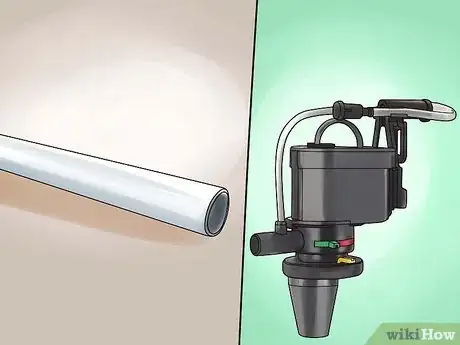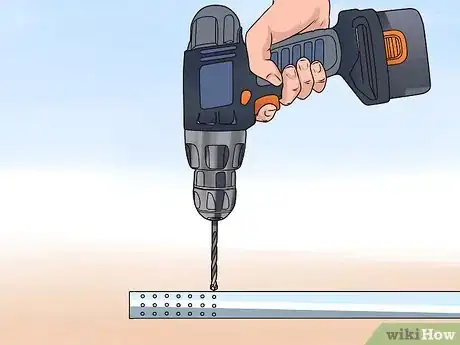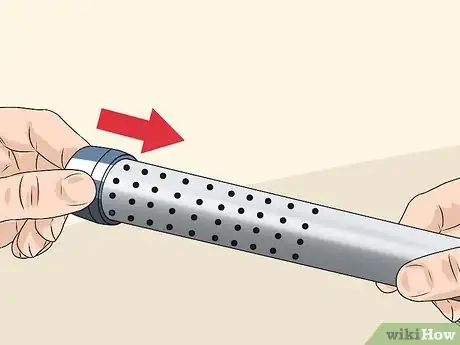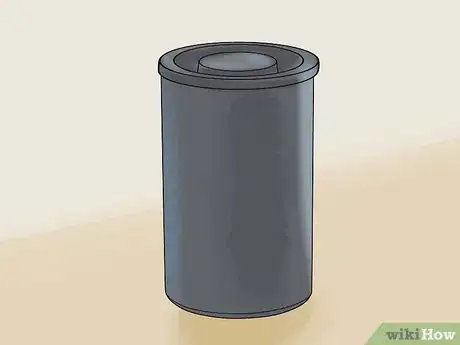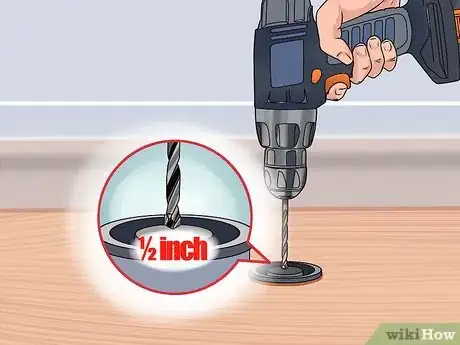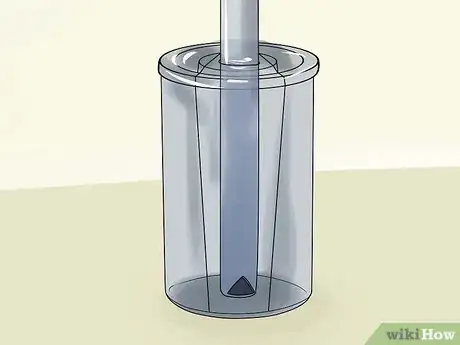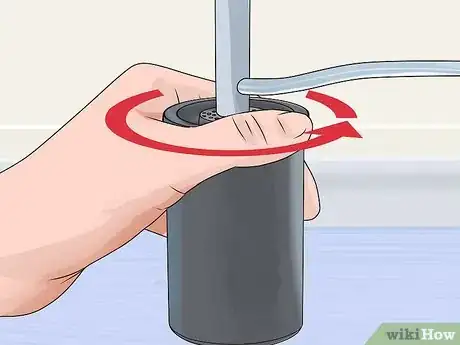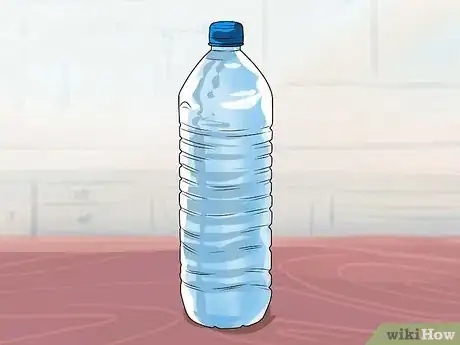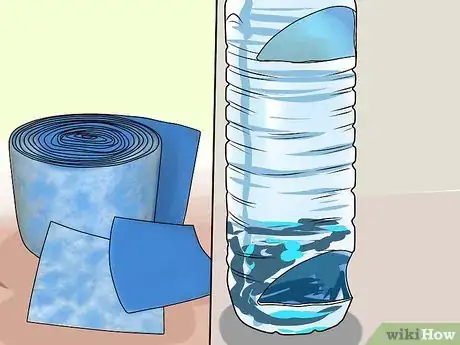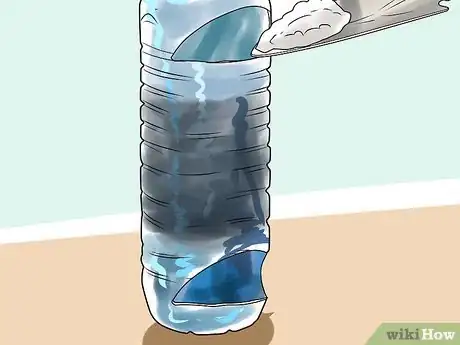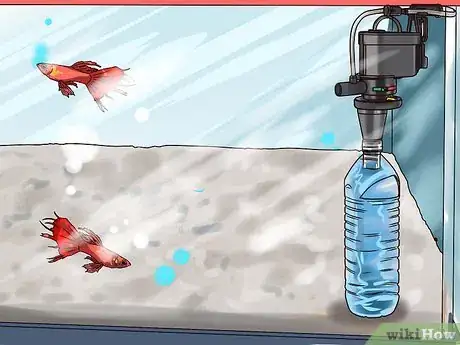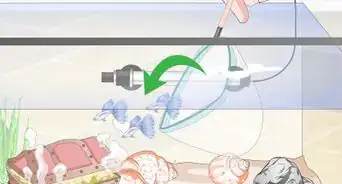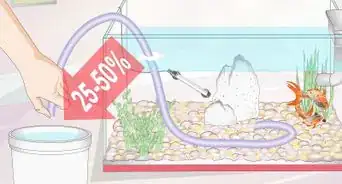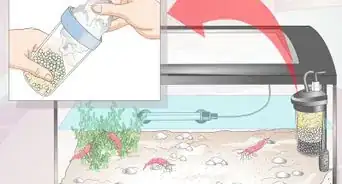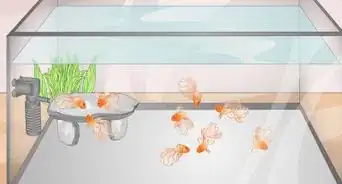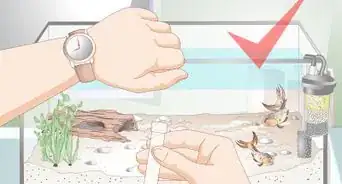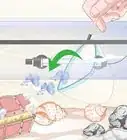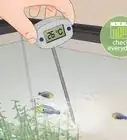This article was co-authored by Marshall Stephens. Marshall Stephens is an Aquarium Expert at Private Oceans Aquariums in West Palm Beach, Florida. Marshall has over 20 years of experience in the aquarium industry and focuses on captive-bred animals. They specialize in tropical and marine aquariums and are a contributor to the Loggerhead Marine life center in Jupiter Florida.
wikiHow marks an article as reader-approved once it receives enough positive feedback. In this case, several readers have written to tell us that this article was helpful to them, earning it our reader-approved status.
This article has been viewed 446,073 times.
Filters can be expensive. Sometimes, it is hard to find the right type of filter, especially if you have a large tank, or fragile fish (such as bettas). Because of this, many aquarium hobbyists choose to make their own filters. This article will show you how to make a few different ones.
Steps
Making a Sponge Filter
-
1Choose a plastic tube large enough to fit the intake valve on your powerhead. The tube does not need to be very long, since the powerhead will be going under water. Plan on getting something at least twice the height of your sponge.
- When choosing a powerhead, get something that will pumps twice as much water per hour as what's in your tank.
- Sponge filters are ideal for delicate tanks.
-
2Choose a filter sponge and cut it down to fit your tank. What brand you use does not matter, but it needs to be the type of sponge used in aquarium filters. The easiest shapes to work with are a triangle or a cylinder. A triangle would fit the easiest in the corner of your fish tank. A cylinder may look neater, however. Whatever shape you choose, make sure that it is wider than your plastic tube.[1]
- You can find filter sponges in pet stores and fish tank stores.
- Consider getting a sponge with larger pores. They are better at housing the good bacteria, which help clean your tank.
- Sponge filters are ideal for shrimp and betta tanks. They are bio efficient, but don't create a lot of suction or water movement.[2]
Advertisement -
3Measure the height of the sponge, and make a mark on the plastic tube. The mark needs to be the same height as the sponge. You will be making air holes in the tube below this mark. These holes will be inside the sponge.
-
4Punch holes into the tube below the mark. You can use a heated nail and hammer to punch the holes, or an electric drill. Plan on making 8 to 10 holes per inch (2.54 centimeters) of plastic tubing.[3]
-
5Plug the bottom of the tube. Make sure that you are plugging the end with all the holes in it. The tube will be going into the sponge, but the bottom still needs to be plugged up. You can use a PVC end cap that fits your tube, or even a piece of styrofoam.
-
6Poke a hole in the sponge with your finger, then slide the tube in. Push it all the way down to the bottom of the sponge. All of the holes in the tube should now be covered by the sponge.
-
7Attach the plastic tube to the intake valve on your powerhead. The powerhead will suck the water in, causing it to go through the sponge. All the mess in your aquarium will get caught in the sponge.
-
8Cut a piece of airline tubing and plug it into the outtake valve of the air pump. The airline tubing doesn't have to be very long, it just needs to fit the aquarium. About 3 to 4 inches (7.62 to 10.16 centimeters) will be enough.[4] The clean water will flow out of this tube.
-
9Place the filter into the fish tank. If your air pump came with suction cups, use those to attach it to the wall of your tank. Angle the output tube so that the water will come out near the surface.
Making a Capsule Filter
-
1Find a small, cylindrical capsule. Film canisters, prescription containers, and empty fish food containers are perfect for this. These filters are great for small tanks.
-
2Clean the capsule using hot water. Do not use any soaps or chemicals, or you will kill your fish. If you are using a film canister, clean it with water and a few drops of a tap water conditioner. Make sure that the conditioner says that it will remove heavy metals. This is because film canisters usually contain traces of heavy metals.
-
3Cut a notch into the bottom end of a plastic tube. Find a ½ inch (1.27 centimeters) wide plastic tube. Cut it down to 6 inches (15.24 centimeters) long. Cut a notch into the bottom of the plastic tube. You can also cut the bottom of the tube at an angle. This will help the water flow better.
- You can find plastic tubes at fish tanks and pet stores. You may also find them in home improvement stores.
-
4Cut a hole in the capsule's lid. The hole should be just a little smaller than your ½ inch (1.27 centimeters) tube. This is so that you get a snug fit, once you put the tube in. You can cut the hole right in the middle of the lid, or close to the edge.
-
5Put the lid onto the capsule and slide the tube all the way down into the capsule. The notched/angled bottom of the tube should be hitting the bottom of the capsule. If you cut the hole close to the edge of the lid, angle the tube so that the notch is facing the center, not the side of the capsule.
-
6Poke holes into the capsule lid using a heated nail and hammer or electric drill. If you take a look at your lid, there should still be some flat area left around the tube. Fill this area with small holes. This is where the bubbles will come out of.
-
7Drill a small hole into the side of the tube. Keep the tube inside the capsule/lid. Measure ½ inch (1.27 centimeters) up from the seam, where the tube meets the lid. Make a small mark. Then, make a hole right on the mark. You can use a heated nail and hammer or an electric drill to do this. The hole should be large enough for a piece of airline tubing to fit through snugly.
- Make the hole just a little smaller than the airline tubing. This will give you a tight fit.
-
8Push the airline tubing into the small hole. Keep feeding it down the bigger tube, until it is about halfway down the capsule. It should not touch the bottom of the capsule.
-
9Lift the lid out of the way. Do not pull the plastic tube out. Keep it pressed firmly against the bottom of your capsule. You will be filling the capsule with filter media next. If you pull the tube away now, the filter media will get stuck under it.
-
10Fill the capsule with your filter media. You can use zeolite, or any other media used in aquarium filters. Activated charcoal is a great, cheap alternative. It works well for removing bacteria. Check your local pet store or fish tank store.
-
11Close the lid tightly, and place the capsule at the bottom of your fish tank. The plastic tube and capsule will both be under water. The airline tubing will go out of the water, and to the air pump.
-
12Attach the other end of the airline tubing to the air pump. Depending on how deep your tank is, and how far away your air pump is, you may need to cut the airline tubing down. Measure the tubing first and trim it down if needed. Plug it into your air pump once it is the right length. Your filter is now ready to use. Position the
Making a Bottle Filter
-
1Choose a water bottle that fits the powerhead. The neck of the bottle should fit right over the intake valve of the powerhead. Remember to choose the right powerhead for your tank; it should pump twice as much water as what's in your tank per hour.
- The more powerful your powerhead is, the larger bottle you will need.
- Bottle filters are great for large tanks.
-
2Cut a large notch into the bottom of the bottle. Cut about two-thirds of the bottom corner out, but leave part of the base intake, or your filter media will fall out. This is where the water will come in and out of.
-
3Fill the bottle a third of the way with filter floss. You can find filter floss in your pet store or in a fish tank store. Try to pack the floss into the bottle, so that it is dense. The filter floss will catch debris.
-
4Add some activated charcoal, or any other filter media. About 2 inches (5.08 centimeters) should be enough.[5] The charcoal will filter out bacteria and toxins.
-
5Fill the rest of the bottle with more filter floss. Remember to pack the filter media somewhat, so that it is snug. The will help filter out the biggest pieces of debris.
-
6Consider wrapping the bottom of the bottle with some fine mesh material. This is not necessary for all tanks, but if you have shrimp, small fish, or delicate fish, this would be a very good idea. Simply wrap some mesh over the hole, and secure it with string. Women's hose are great for this.[6]
-
7Stick the intake valve of the powerhead into the mouth of the bottle. The intake valve will suck the dirty water into the bottle. The filter media inside will clear all of the dirt out.
-
8Fit a piece of airline tubing onto the output nozzle of the powerhead. A 3 inch (7.62 centimeters) long piece will be enough. The clean water will come out of this tube.
-
9Place the filter in your tank. If the powerhead has suction cups, use them to attach it to the wall of your tank. Angle the airline tubing towards the surface of the water.
Community Q&A
-
QuestionHow do I put filter floss into the bottle filter?
 Community AnswerRoll the filter floss to the size/thinness you need, then use a solvent and liquid to make the floss slippery enough to get inside the bottle filter.
Community AnswerRoll the filter floss to the size/thinness you need, then use a solvent and liquid to make the floss slippery enough to get inside the bottle filter. -
QuestionCan I use something else instead of a mesh?
 anime obsessing bleachCommunity AnswerYou can use old pantyhose.
anime obsessing bleachCommunity AnswerYou can use old pantyhose. -
QuestionI installed an ultraviolet chamber in a 40 gallon tank with amazing results! Soon turned into fuzzy overgrowth of rusty colored mess throughout the tank -- are they related? Is it bacteria or algae? Do I need a test?
 Titans - Gaming and moreCommunity AnswerIt's probably bacteria, test if you are concerned, but it's probably nothing. Monitor it for about a week and if any problems come up have a test.
Titans - Gaming and moreCommunity AnswerIt's probably bacteria, test if you are concerned, but it's probably nothing. Monitor it for about a week and if any problems come up have a test.
Warnings
- Regularly check your filter to make sure that it is still working. A malfunctioning pump is hazardous for your fish as well as you.⧼thumbs_response⧽
- Never use soap or chemicals to clean anything you'll be putting inside your fish tank. Even the slightest residue will kill your fish. Use hot water only, and aquarium water conditioner if needed.⧼thumbs_response⧽
Things You'll Need
Making a Sponge Filter
- Filter sponge
- Knife
- Plastic tube
- Hammer and nail or electric drill
- Airline tubing
- Powerhead
Making a Capsule Filter
- Capsule (film canister, prescription container, fish food container
- ½ inch (1.27) thick plastic tube
- Airline tubing
- Nail and hammer, or electric drill
- Filter media
- Air pump
Making a Bottle Filter
- Powerhead
- Water bottle
- Aquarium filter floss
- Activated charcoal
- Airline tubing
Expert Interview
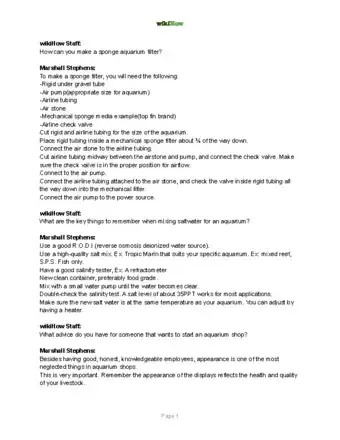
Thanks for reading our article! If you'd like to learn more about aquariums, check out our in-depth interview with Marshall Stephens.
References
- ↑ http://www.ratemyfishtank.com/blog/how-to-make-your-own-sponge-filter
- ↑ http://www.americanaquariumproducts.com/sponge_filtration.html
- ↑ http://www.ratemyfishtank.com/blog/how-to-make-your-own-sponge-filter
- ↑ http://www.ratemyfishtank.com/blog/how-to-make-your-own-sponge-filter
- ↑ http://www.dramaticaquascapes.com/doityourselfwaterbottlepowerfilter.html
- ↑ http://www.dramaticaquascapes.com/doityourselfwaterbottlepowerfilter.html
About This Article
To make an underwater aquarium filter out of a water bottle, start by cutting a large notch into the side of the bottle toward the bottom. Then, densely fill the bottle 1/3 of the way with filter floss, followed by 2 inches of activated charcoal to filter out bacteria and toxins. Next, snugly fill the rest of the bottle with more filter floss and cover the opening at the bottom with fine mesh, like a piece of women’s hose. Finally, stick the intake valve of the powerhead into the mouth of the bottle and attach 3 inches of airline tubing into the output nozzle before putting the filter into the tank. For tips on how to make a sponge filter that’s ideal for a tank with delicate fish, read on!
